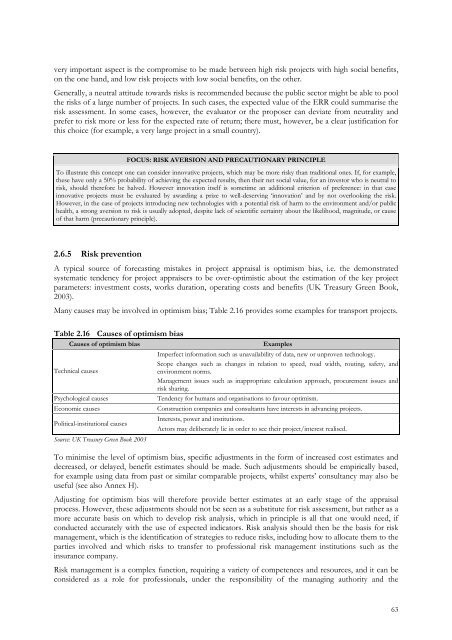Guide to COST-BENEFIT ANALYSIS of investment projects - Ramiri
Guide to COST-BENEFIT ANALYSIS of investment projects - Ramiri
Guide to COST-BENEFIT ANALYSIS of investment projects - Ramiri
Create successful ePaper yourself
Turn your PDF publications into a flip-book with our unique Google optimized e-Paper software.
very important aspect is the compromise <strong>to</strong> be made between high risk <strong>projects</strong> with high social benefits,on the one hand, and low risk <strong>projects</strong> with low social benefits, on the other.Generally, a neutral attitude <strong>to</strong>wards risks is recommended because the public sec<strong>to</strong>r might be able <strong>to</strong> poolthe risks <strong>of</strong> a large number <strong>of</strong> <strong>projects</strong>. In such cases, the expected value <strong>of</strong> the ERR could summarise therisk assessment. In some cases, however, the evalua<strong>to</strong>r or the proposer can deviate from neutrality andprefer <strong>to</strong> risk more or less for the expected rate <strong>of</strong> return; there must, however, be a clear justification forthis choice (for example, a very large project in a small country).FOCUS: RISK AVERSION AND PRECAUTIONARY PRINCIPLETo illustrate this concept one can consider innovative <strong>projects</strong>, which may be more risky than traditional ones. If, for example,these have only a 50% probability <strong>of</strong> achieving the expected results, then their net social value, for an inves<strong>to</strong>r who is neutral <strong>to</strong>risk, should therefore be halved. However innovation itself is sometime an additional criterion <strong>of</strong> preference: in that caseinnovative <strong>projects</strong> must be evaluated by awarding a prize <strong>to</strong> well-deserving ‘innovation’ and by not overlooking the risk.However, in the case <strong>of</strong> <strong>projects</strong> introducing new technologies with a potential risk <strong>of</strong> harm <strong>to</strong> the environment and/or publichealth, a strong aversion <strong>to</strong> risk is usually adopted, despite lack <strong>of</strong> scientific certainty about the likelihood, magnitude, or cause<strong>of</strong> that harm (precautionary principle).2.6.5 Risk preventionA typical source <strong>of</strong> forecasting mistakes in project appraisal is optimism bias, i.e. the demonstratedsystematic tendency for project appraisers <strong>to</strong> be over-optimistic about the estimation <strong>of</strong> the key projectparameters: <strong>investment</strong> costs, works duration, operating costs and benefits (UK Treasury Green Book,2003).Many causes may be involved in optimism bias; Table 2.16 provides some examples for transport <strong>projects</strong>.Table 2.16 Causes <strong>of</strong> optimism biasCauses <strong>of</strong> optimism biasExamplesImperfect information such as unavailability <strong>of</strong> data, new or unproven technology.Scope changes such as changes in relation <strong>to</strong> speed, road width, routing, safety, andTechnical causesenvironment norms.Management issues such as inappropriate calculation approach, procurement issues andrisk sharing.Psychological causesTendency for humans and organisations <strong>to</strong> favour optimism.Economic causesConstruction companies and consultants have interests in advancing <strong>projects</strong>.Interests, power and institutions.Political-institutional causesAc<strong>to</strong>rs may deliberately lie in order <strong>to</strong> see their project/interest realised.Source: UK Treasury Green Book 2003To minimise the level <strong>of</strong> optimism bias, specific adjustments in the form <strong>of</strong> increased cost estimates anddecreased, or delayed, benefit estimates should be made. Such adjustments should be empirically based,for example using data from past or similar comparable <strong>projects</strong>, whilst experts’ consultancy may also beuseful (see also Annex H).Adjusting for optimism bias will therefore provide better estimates at an early stage <strong>of</strong> the appraisalprocess. However, these adjustments should not be seen as a substitute for risk assessment, but rather as amore accurate basis on which <strong>to</strong> develop risk analysis, which in principle is all that one would need, ifconducted accurately with the use <strong>of</strong> expected indica<strong>to</strong>rs. Risk analysis should then be the basis for riskmanagement, which is the identification <strong>of</strong> strategies <strong>to</strong> reduce risks, including how <strong>to</strong> allocate them <strong>to</strong> theparties involved and which risks <strong>to</strong> transfer <strong>to</strong> pr<strong>of</strong>essional risk management institutions such as theinsurance company.Risk management is a complex function, requiring a variety <strong>of</strong> competences and resources, and it can beconsidered as a role for pr<strong>of</strong>essionals, under the responsibility <strong>of</strong> the managing authority and the63




